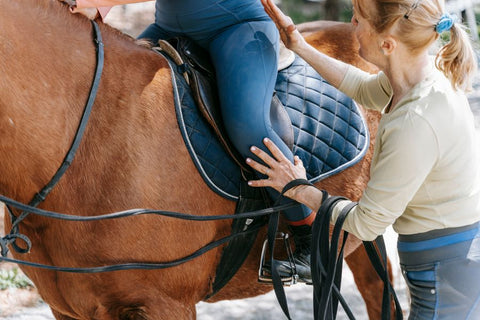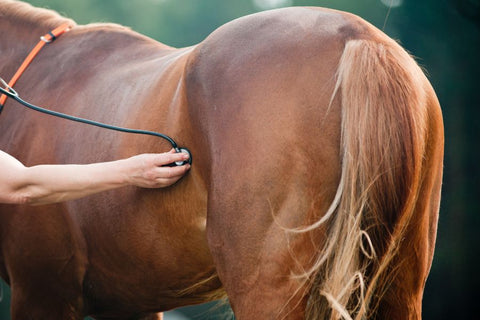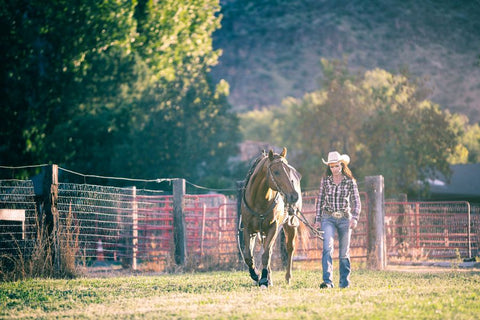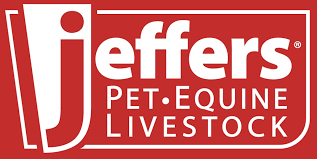Purchasing a Horse Series: An Overview of the Entire Process
Purchasing a horse is a massive responsibility. There's so much that goes into it, other than saddling up and riding whenever you want (though this is admittedly a major perk). You'll spend far more time caring for your horse than you will in the saddle, but the rewards of horse ownership are immeasurable.
This series of articles will explore horse ownership. Today, we're taking an overview of where to kick off your journey all the way through to finalizing the deal. If you're unfamiliar with the process, or you need a few reminders, this is a great place to start!
Ownership Responsibilities
There are many nuances of owning a horse. It's impossible to list everything you might encounter along the way, but it always involves financial and time commitments. It's essential to evaluate your budget and how much time you can realistically dedicate to the care of your new horse.
Horses that receive regular attention tend to have better attitudes and manners. This includes feeding, grooming, exercising, and veterinary care. Consistent riding and interaction contribute to a more obedient and well-behaved horse.
Consider the ongoing expenses of horse ownership, including feed, boarding or stabling costs, farrier services, veterinary care, and equipment. The cost can vary widely depending on your location and the level of care your horse requires, but it's vital to be prepared.
Riding Lessons are a Must

You don't have to jump right into a purchase if you're not quite ready. If you aren't already, taking riding lessons is a great place to start and satisfy your equine addiction.
Lessons are an essential part of your equestrian education. When paired with a reputable trainer, lessons will improve your riding skills. You'll also enhance your understanding of horsemanship and explore different disciplines.
Riding lessons are an essential step in preparing for horse ownership. Whether you are a beginner or have some riding experience, lessons offer numerous benefits, including:
- Skill Improvement: Lessons help you improve your riding skills, balance, and overall horsemanship.
- Learning New Disciplines: You can explore different riding disciplines, from Western to English, dressage to jumping, to find your preferred style.
- Working Toward a Better Ride: Instructors can guide you in refining your riding techniques and achieving a better partnership.
Choose your instructor carefully based on your goals and experience level. The horses available for you to ride during lessons should be healthy, well-tempered, and trained to match your skill level. Riding lessons provide the foundation for becoming a responsible and competent horse owner.
Horse-Leasing Options
Horse leasing can be an attractive alternative to full ownership for many. Through a lease, you can experience the joys of horse ownership without taking on the long-term responsibilities.
It's essential to understand the terms and conditions of your lease agreement fully. When leasing a horse, both the owner and the lessee should have a written contract. Your contract should include but is not limited to details such as:
- Liability: Define who is responsible for injuries or damage caused by the horse during the lease period.
- Farrier and Vet Expenses: Clarify how these costs will be divided between the owner and lessee.
- How the Horse Will Be Used: Specify the purpose of the lease, such as trail riding or competition.
- General Horse Care Expected by Owner: Outline the care requirements and expectations set by the horse's owner.
- Contact Information: Ensure both parties have each other's contact information for communication during the lease.
- Insurance Requirements: Determine whether the lessee is required to obtain liability insurance during the lease.
Buying the Right Horse

Once you've prepared through lessons or leasing, it's time to find the perfect horse for you! When searching for the right horse, consider the following factors, as they can influence your decision.
Breed Considerations
Most horses are bred with specific criteria in mind. For example, Thoroughbreds are known for their speed and stamina, but they can be high-energy and require experienced riders.
On the other hand, stock breeds like Paints and Quarter Horses are often calm, flat-moving, and suitable for many riders.
Intended Use
Determine your primary goal for owning a horse. If you're interested in showing or competing, be prepared for the associated costs. Show horses can be expensive to purchase and maintain in show condition.
Prices can range from $5,000 for an unproven horse to ten times that amount for an experienced one. Show barns will have their own expenses for training, lessons, and board.
Value vs. Suitability
While the cost of a horse can vary significantly, the most valuable horse is one that is comfortable and safe for you to ride. Suitability to the rider should be the primary consideration.
Breed preference is a matter of personal choice, and choosing a grade horse (a horse without registration papers, typically of an unknown breed) is perfectly fine.
Registered horses are simply recognized by a breed association and often come with a higher price tag. Remember, the monetary value of a horse should be secondary to its suitability for your riding style and experience level.
Age, Size and Disposition
Don't be overly concerned about the horse's age. Some younger horses are laid-back and easy to handle, while some in their twenties can be spirited and require an advanced rider.
Old age does not guarantee a good disposition. Focus on finding a horse with a calm and pleasant demeanor without behavioral issues like rearing, kicking, bucking, or biting.
Size can be tricky. If you're on the short side, you might struggle with a tall horse. On the other hand, smaller horses or large ponies sometimes cannot handle the weight of an adult rider.
The most important factor is weight. The general rule here is that a horse shouldn't carry more than 20% of its body weight, including tack. This number varies based on many factors.
The Prospect
It's time to take a closer look at your new four-legged friend. Assess the horse's long-term serviceable soundness. Is he or she likely to stay healthy and usable for the next 5-7 years?
While this may not be a concern if you don't plan to ride extensively, it's essential to avoid an overabundance of vet bills right from the start. Many sound horses may have issues like arthritis, which is manageable with proper care.
Look for a horse that is nicely put together, with balanced conformation. However, remember that manners and disposition are far more critical.
Avoid the assumption that you can easily change bad habits in a horse. It's dangerous to take on a horse with severe behavioral issues unless you are a professional trainer seeking a challenge.
Where Can I Shop for a Horse?

When it comes to buying a horse, it's crucial to bring along a knowledgeable friend or trainer. Emotions can cloud your judgment, making it challenging to make a rational decision. Here are some places to explore when looking for a horse:
- Private Sellers: Individuals selling their horses privately may have a more personal connection with the animals and can provide valuable insights into their history and behavior.
- Breeders: Reputable breeders often have well-bred horses with detailed pedigrees. They can be a source of quality horses, especially if you're interested in a specific breed.
- Auctions: Horse auctions offer a variety of horses, but they can be a risky place for inexperienced buyers. Proceed with caution and seek expert advice.
- Rescue Organizations: Rescuing a horse in need can be a rewarding experience. Many rescued horses are in search of loving homes.
- Trainers and Riding Schools: Some trainers and riding schools sell horses they have trained or used for lessons. These horses may be well-suited for novice riders.
Regardless of where you shop for a horse, always bring someone who is very familiar with the sales part of the industry.
The First Visit
When visiting a horse for sale, follow these steps to ensure a thorough evaluation:
- Watch the Horse with Other Horses: Observe how the horse interacts with other horses in the same environment.
- Watch the Owner Handle the Horse: Pay attention to how the owner approaches and handles the horse, as this can reveal the horse's temperament.
- Watch the Owner Ride the Horse: Evaluate the horse's behavior and performance under the owner's guidance.
- Watch an Expert Ride the Horse: If possible, observe an experienced rider or trainer riding the horse to assess its behavior and skills.
- Ride the Horse: If all the previous steps go well, you can proceed to ride the horse yourself. However, prioritize safety. If you have any doubts or concerns about the horse's suitability, it's better not to ride. Safety should always come first.
- Ask Lots of Questions: Gather as much information as possible about the horse's history, training, behavior, and any specific requirements it may have.
Questions to Ask
When evaluating a potential horse, it's essential to ask the right questions so you can put together a picture of the horse's background and suitability. Here are some key questions to consider:
Health History
- Has the horse ever foundered (experienced laminitis)?
- Does the horse have a history of colic or digestive issues?
- Has the horse had any past lameness issues?
- Are there any respiratory issues or surgeries in the horse's history?
Shoes
- Does the horse wear shoes?
- How frequently does the horse require shoeing?
- How does the horse behave for the farrier? Is it cooperative during hoof care?
Behavior
- Does the horse have a history of bad behavior, such as biting or kicking?
- How does the horse behave during feeding and turnout?
- Has the horse been exposed to trail rides, and if so, how does it respond to different environments?
- Does the horse have experience in shows or competitions?
- Can you obtain information about the horse's past owners and their experiences with the horse?
- What type of tack (saddle, bridle, etc.) does the horse prefer?
If the horse is registered, ensure that you receive the necessary registration papers and documentation.
Your Second Visit
It's wise to conduct an unannounced second visit to see the horse in its natural environment without any special preparation by the owner. This visit can help you gauge the horse's genuine behavior and temperament.
It might seem rude to just show up, but it's typically well worth it. If the second visit goes well, it's time to proceed with the Pre-Purchase Exam (PPE).
Your Pre-Purchase Exam

The Pre-Purchase Exam (PPE) is a critical step in the horse-buying process. It involves a thorough veterinary examination to assess the horse's overall health and soundness.
Select a veterinarian who is not associated with the seller or the horse's current location to ensure an unbiased evaluation. Here are a few things you should know.
X-Rays May Be Necessary
If you have concerns about the horse's soundness, discuss the possibility of taking X-rays. X-rays can reveal underlying issues that may not be visible during a standard physical examination.
Few Horses Pass a PPE
It's important to understand that very few horses pass a PPE without any issues. Horses, like people, can have minor health concerns that are manageable. Be prepared to discuss and negotiate how you can manage these problems and if it makes sense for you.
Watch for Warning Signs
During the PPE and throughout the evaluation process, watch for signs of pain or underlying issues in the horse:
- Tail swishing
- Ear pinning
- Diving toward the center of the arena or pulling back toward the barn
- Resistance to aids (such as moving forward or responding to cues)
- Sore back, as indicated by sensitivity to touch or pressure
- Under or overweight (a body condition score of 5 is ideal)
A knowledgeable veterinarian can help you interpret these signs and their significance.
Finalizing the Deal
How exciting! You've made it through the muck that is purchasing a horse and you are close to finalizing the deal. Keep this advice in mind:
- Avoid Pressure: If you ever feel pressured to make a quick decision, it's best to walk away. The horse-buying process should be thoughtful and deliberate.
- Take Your Time: Even if a horse is in high demand, take the time you need to make an informed decision. Rushing into a purchase can lead to regrets.
- Sign a Purchase Contract: Always sign a formal purchase contract that outlines the terms and conditions of the sale. Do not rely solely on a handshake agreement.
- Obtain Necessary Papers: Ensure you receive all required documentation, including registration papers, health records, and any relevant information about the horse's history.
It Doesn't End Here...

Purchasing a horse is a journey that requires extensive knowledge and preparation. While we've covered the basics in this article, there's much more to explore. Stay tuned for more pieces in this "Purchasing a Horse Series", where we'll jump into conformation, youth horses, and so much more!
When you have the proper knowledge, your purchasing experience will go much more smoothly, at least when it comes to the parts you can control!
















































